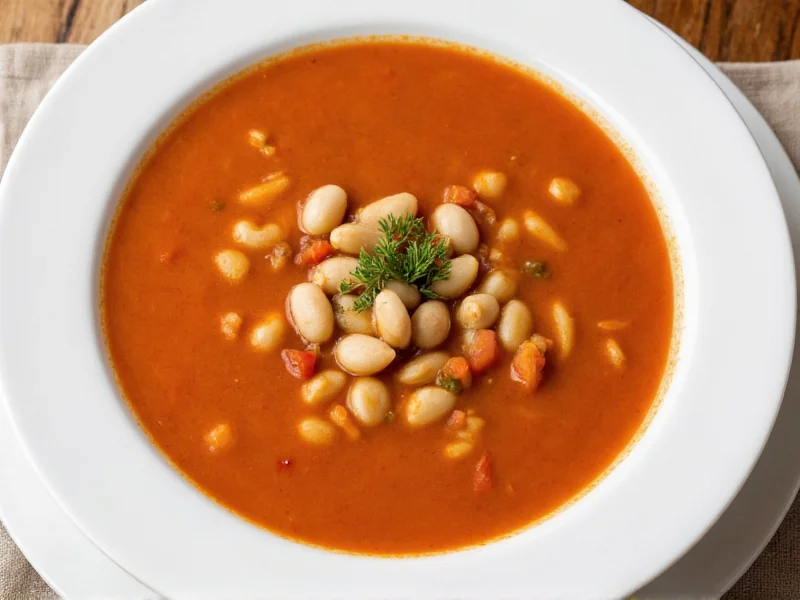White bean tomato soup represents the perfect marriage of pantry staples and fresh ingredients for a nourishing meal. This versatile dish transforms simple canned beans and tomatoes into a creamy, satisfying soup without requiring dairy. Home cooks appreciate its quick preparation time and impressive nutritional profile, making it ideal for weeknight dinners or meal prep.
Why This Soup Deserves a Spot in Your Recipe Rotation
The magic of white bean tomato soup lies in its balance of convenience and nutrition. Unlike many canned soups, homemade versions control sodium levels while maximizing flavor through proper seasoning techniques. The combination of white beans and tomatoes creates a naturally creamy texture through emulsification during blending, eliminating the need for heavy cream while maintaining richness.
Essential Ingredients and Their Purpose
Understanding each component's role ensures optimal results. While substitutions exist, these core ingredients form the foundation:
- Cannellini beans - Their mild flavor and creamy texture blend perfectly, providing protein and fiber
- San Marzano tomatoes - These plum tomatoes offer balanced sweetness and acidity
- Garlic and onion - Create aromatic depth when properly sautéed
- Fresh rosemary - Adds earthy complexity that dried herbs can't match
- Extra virgin olive oil - Enhances flavor absorption and mouthfeel
Step-by-Step Preparation Guide
Follow these professional techniques for restaurant-quality results at home:
- Sauté aromatics: Cook diced onion in olive oil over medium heat until translucent (5-7 minutes)
- Add garlic and herbs: Stir in minced garlic and rosemary for 1 minute until fragrant
- Incorporate tomatoes: Pour in crushed tomatoes with their juices, scraping browned bits from pan
- Add beans and broth: Stir in rinsed cannellini beans and vegetable broth
- Simmer gently: Cook uncovered for 15 minutes to develop flavors
- Blend carefully: Use immersion blender to partially puree while maintaining some texture
- Finish with greens: Stir in chopped kale or spinach during last 5 minutes of cooking
- Season properly: Adjust salt, pepper, and acid (lemon juice or red wine vinegar) to taste
Nutritional Benefits Breakdown
This soup delivers remarkable nutrition per serving (1.5 cups). The combination of white beans and tomatoes creates a complete protein profile while providing essential vitamins and minerals.
| Nutrient | Amount per Serving | Daily Value % |
|---|---|---|
| Calories | 285 | 14% |
| Protein | 15g | 30% |
| Fiber | 12g | 43% |
| Vitamin C | 35mg | 39% |
| Iron | 4.5mg | 25% |
Variations for Dietary Preferences
Adapt this base recipe to accommodate various dietary needs without sacrificing flavor:
- Vegan version: Skip Parmesan garnish and use nutritional yeast for umami flavor
- Lower sodium option: Use no-salt-added tomatoes and low-sodium broth
- Extra protein boost: Add 1/2 cup cooked lentils during simmering
- Spicy variation: Include red pepper flakes with aromatics
- Creamier texture: Blend all ingredients completely for bisque-style soup
Storage and Reheating Best Practices
White bean tomato soup maintains quality exceptionally well in storage. Follow these guidelines for optimal results:
- Cool completely before storing to prevent condensation
- Refrigerate in airtight containers for up to 5 days
- Freeze in portion-sized containers for up to 3 months
- Reheat gently on stove over medium-low heat
- Add splashes of broth when reheating to restore consistency
- Finish with fresh herbs after reheating for maximum flavor
Common Preparation Mistakes to Avoid
Professional chefs consistently identify these errors that compromise soup quality:
- Skipping the sauté step - Properly cooking aromatics builds essential flavor foundation
- Over-blending - Maintain some bean texture for satisfying mouthfeel
- Underseasoning - Acid balance (lemon/vinegar) is crucial for brightening flavors
- Using dried herbs instead of fresh - Rosemary and thyme work best fresh in this application
- Adding greens too early - Delicate greens become overcooked and lose nutrients
Frequently Asked Questions
Can I make white bean tomato soup without an immersion blender?
Yes, you can achieve similar results by transferring cooled soup in batches to a standard blender. For safety, fill blender only halfway, leave the center cap off, and cover with a towel to allow steam to escape while blending. Pulse carefully until desired consistency is reached.
What's the best way to thicken white bean tomato soup naturally?
The most effective natural thickening method involves reserving one cup of beans before blending, then mashing them with a fork and stirring back into the soup. This technique maintains the soup's integrity while creating ideal texture without flour or cornstarch.
How can I enhance the umami flavor in vegetarian white bean tomato soup?
Boost umami naturally by adding one of these ingredients during cooking: 2-3 rehydrated dried mushrooms, 1 tablespoon tomato paste cooked with aromatics, or 1/2 teaspoon soy sauce. These ingredients deepen flavor complexity without overpowering the soup's fresh character.
Which white beans work best for creamy tomato soup?
Cannellini beans provide the ideal balance of creaminess and mild flavor. Great Northern beans offer a slightly firmer texture, while navy beans create a denser soup. Avoid chickpeas or kidney beans as their stronger flavors and textures don't complement tomato as well.
Can I prepare white bean tomato soup in a slow cooker?
Absolutely. Sauté aromatics first, then transfer to slow cooker with remaining ingredients. Cook on low for 4-6 hours. Add greens during the last 30 minutes. The slow cooking process develops deeper flavors, though you'll still need to blend partially for proper texture before serving.











 浙公网安备
33010002000092号
浙公网安备
33010002000092号 浙B2-20120091-4
浙B2-20120091-4